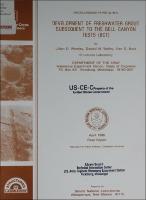Please use this identifier to cite or link to this item:
https://hdl.handle.net/11681/11089| Title: | Development of freshwater grout subsequent to the Bell Canyon Tests (BCT) |
| Authors: | Sandia National Laboratories Wakeley, Lillian D. Walley, Donald M. Buck, Alan D. |
| Keywords: | Bell Canyon Test Physical properties Waste Isolation Pilot Plant New Mexico Grout Radioactive waste disposal Microstructure Repository sealing |
| Publisher: | Structures Laboratory (U.S.) Engineer Research and Development Center (U.S.) |
| Series/Report no.: | Miscellaneous paper (U.S. Army Engineer Waterways Experiment Station) ; SL-86-2. |
| Description: | Miscellaneous Paper Abstract: Freshwater grouts are among the cement-based materials developed and studied at the US Army Engineer Waterways Experiment Station (WES) for sealing a radioactive waste repository in bedded evaporite rocks. The grout most studied was first developed for the Bell Canyon Tests (BCT) at the Waste Isolation Pilot Project (WIPP) in southeastern New Mexico. This salt-free grout, designated BCT-1FF, was placed in the field in 1981 (Site and Preliminary Design Validation, or SPDV) and again in 1983 (B-25 borehole). Casting of specimens for laboratory study at WES accompanied both of these field events. Specimens were tested to ages of nearly four years for such properties as expansion, compressional wave velocity, compressive strength, static and dynamic elastic moduli, and phase composition. Most properties achieved the values for which this mixture was developed. Changes in some parameters, such as increases in density and expansion, can be related directly to phase composition and microstructure. The BCT-1FF grout is the baseline candidate freshwater grout for future studies and development of the WIPP as a demonstration geologic repository. |
| Rights: | Approved for public release; distribution is unlimited. |
| URI: | http://hdl.handle.net/11681/11089 |
| Appears in Collections: | Miscellaneous Paper |
Files in This Item:
| File | Description | Size | Format | |
|---|---|---|---|---|
| MP-SL-86-2.pdf | 7.56 MB | Adobe PDF |  View/Open |